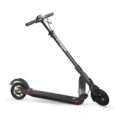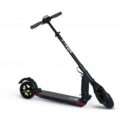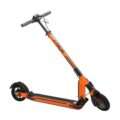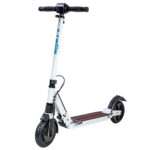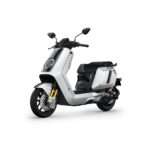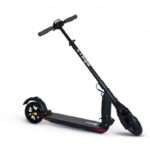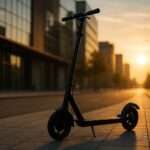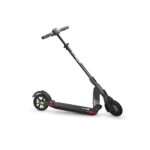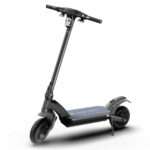- Home
- Scooters
- Electric Scooters
- E-TWOW S2 Booster
E-TWOW S2 Booster


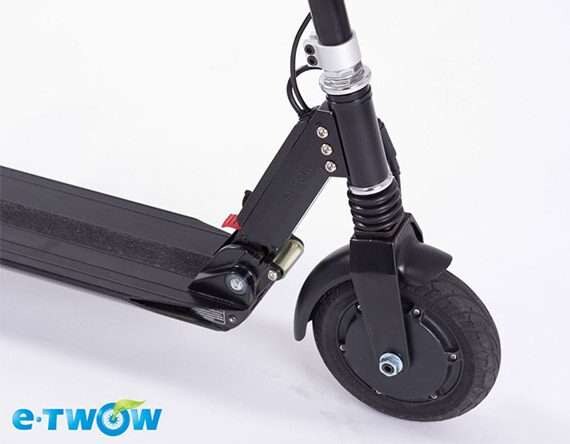
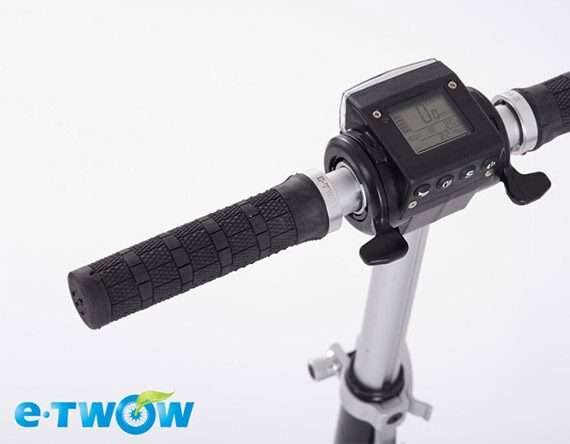
- Battery Range: 16–19 miles (25–30 km)
- Top Speed: 18.6 mph (30 km/h)
- Motor Power: 500 W
- Weight Capacity: 242 lb (110 kg)
- Charging Time: ~2–3 h
- Scooter Weight: 25.6 lb (11.6 kg)
PROS
- Ultra-portable 25.6 lb design
- Front & rear suspension (spring)
- Regenerative braking (KERS)
- Bluetooth app with lock & speed limit
- Adjustable handlebar + compact fold
CONS
- Solid 8″ tires feel firm on rough roads
- Moderate hill climbing (rated 20°)
- Braking relies on regen + rear foot brake unless drum option is fitted
Key Takeaways
- The E-TWOW S2 Booster is an ultra-portable scooter designed for city commuting, featuring a light frame and easy folding mechanism.
- It offers performance with a top speed of up to 22 mph and efficient regenerative braking, enhancing ride quality in urban settings.
- Real-world range varies, typically offering 10-16 miles per charge, making it suitable for short trips.
- Maintenance is minimal, mainly involving checks on the folding latch, stem clamp, and rear brake pad.
- The scooter serves well for students and commuters, balancing portability with speed but may not be ideal for rough terrain or steep hills.
Table of contents
- What Is the E-TWOW S2 Booster?
- How the E-TWOW S2 Booster Works
- Key Specifications
- Design & Build Quality
- Performance Fundamentals
- Battery, Range & Efficiency
- Ride Quality & Comfort
- Braking & Safety Features
- Portability & Daily Usability
- Maintenance & Care
- Weather & Seasonal Considerations
- E-TWOW S2 Booster vs Alternatives
- Who the E-TWOW S2 Booster Is (and Isn’t) For
- FAQs
- Glossary
- Extra Build Notes
- Performance Tuning Tips
- Battery Care Habits
- Comfort Upgrades and Fit
- One-Minute Pre-Ride Check
- Riding Etiquette and Path Choices
- Storage and Transport
- Troubleshooting Quick Hits
- Final Thoughts
The E-TWOW S2 Booster is a fast. light. fold-and-go scooter for city life. It suits riders who want simple upkeep and easy storage. It feels quick off the line and smooth at cruise. So it fits students, last-mile commuters, and anyone who needs a compact daily ride.
What Is the E-TWOW S2 Booster?
The S2 Booster sits in the ultra-portable class. It focuses on low weight, quick folding, and a clean look. The deck is slim, and the stem is telescopic. The tires are solid, so flats do not end your day. Front and rear springs knock down harsh bumps. Regen braking slows the wheel and sips a little energy back into the battery.
The S2 line has been around for years. Small differences show up across batches. The idea stays the same. You get a compact fold, a peppy motor, a narrow deck, and clear controls. That combination makes the scooter easy to live with.
How the E-TWOW S2 Booster Works
Think of it like this. Your right thumb tells the controller what you want. The controller sends power from the deck battery to the front hub motor. Power comes on in a steady way. Low-speed control feels natural in crowds. So you can roll through bike lanes and sidewalks without drama.
The battery sits inside the deck. The system is 36 V nominal. Many packs land in the 7–8 Ah range. That puts energy near 250–300 Wh. The charge port is on the deck. A full charge with the stock brick takes about 3–4 hours. Then you unplug and ride.
Two braking tools work together. Electronic regen slows the motor and recovers a bit of energy. The rear fender brake adds friction you can feel under your foot. Most riders lean on regen for daily stops. Then they add the foot brake on steep slopes or short gaps.
The cockpit keeps things simple. A small display shows speed, battery bars, and trip data. Two buttons handle mode and lights. Cruise control appears on many units. Hold a steady pace for a few seconds. The scooter locks that speed until you touch throttle or brake. That makes long straight sections easier.
Key Specifications
Use this quick table when you want the facts in one place. Values reflect common S2 Booster units. Small changes can appear by year or sub-model.
| Block | Details |
|---|---|
| General | Model: E-TWOW S2 Booster. Urban commuting and last-mile trips. Aluminum alloy frame. Telescopic stem with quick clamp. |
| Performance & Power | Top speed up to 22 mph (35 km/h) depending on settings. Front hub motor near 500 W nominal with higher peak on launch. Handles short city slopes around ~7–10% with momentum. Multiple speed modes. Cruise control on many units. |
| Battery, Charging & Electrical | 36 V nominal system. Common packs ~7–8 Ah. Energy about 250–300 Wh. Rated range up to 20–22 miles (32–35 km) in ideal tests. Charge time about 3–4 hours with the stock charger. Built-in BMS with cell protections. |
| Build & Dimensions | Weight about 24–25 lb (11–11.5 kg). Unfolded ~42.5 × 16.5 × 44.5 in (108 × 42 × 113 cm). Folded ~42.5 × 5.9 × 13.6 in (108 × 15 × 34.5 cm). Usable deck length ~18–19 in (46–48 cm). Deck width ~5.5–6.0 in (14–15 cm). Telescopic stem. |
| Safety & Control | Electronic regenerative front brake and rear foot brake. 8-inch solid rubber tires. Front and rear springs. Stem-mounted headlight, rear light, side reflectors. |
| Features & Extras | Backlit display for speed and battery. Cruise control on many units. Electric horn on most versions. Side kickstand. Some batches include Bluetooth. |
| Warranty & Compliance | Warranty terms vary by seller and region. Local rules differ by city and country. Follow posted limits and allowed paths. |
These specifications set clear expectations. They frame what the chassis, battery, and motor can deliver. So keep them in mind as you plan routes and daily habits.
Design & Build Quality
The S2 Booster looks neat and compact. The narrow deck invites a snowboard-style stance. The rubberized deck grip feels planted in light spray. The stem latch closes with a firm click. The height clamp holds well when you set it with care. The result feels tight and quiet once you roll.
The cockpit is minimal by design. A centered display shows the basics. The right thumb throttle has a short throw and sits close to the grip. That placement makes small speed changes easy. Regen comes in as you ease off the throttle. The rear fender brake gives you a second layer of stopping power you can feel through your shoe.
Fit and finish are tidy. The hinge sits low. The latch opens with one hand. The folded stem rests near the deck so the scooter becomes a slim rectangle. Internal routing keeps cables out of the way. Nothing loops to snag while you fold.
Suspension parts are small but useful. Short springs sit near the pivots. Travel is limited, and potholes still feel firm. Yet brick seams and cracks do not sting your ankles. Solid tires support the low-weight goal and kill puncture drama. The trade is a firmer feel on coarse pavement.
Performance Fundamentals
Starts feel lively after a short push. Throttle response is direct and predictable. Rolling to city speeds takes about a block. The scooter holds pace on flat streets without gulping power. So the battery lasts longer than you expect at calm speeds.
Stability stays solid across normal commuter speeds. The deck is narrow. Foot placement matters. Put your lead foot near the front with a slight angle. Place your rear foot across the deck near the tail. That stance anchors your hips and keeps your knees ready for bumps. The stem can flex a bit on sharp hits. It does not feel loose in daily riding. The chassis tracks cleanly through mild curves.
Short hills with 7–10% grades are fine when you keep momentum. Enter with some speed. Hold throttle. The scooter crests without drama. Long steep climbs slow a light chassis. Plan routes that skirt long hills when you can.
Battery, Range & Efficiency
Real-world range shifts with rider weight, speed, wind, slope, and temperature. Many riders see 10–16 miles (16–26 km) per charge in mixed city use. Lower speeds help. Cold weather trims range. Heavier riders and rolling routes cut miles as well. So adjust your plan with the season and your pace.
The pack sits low in the deck. Warm days and long pulls can heat the controller. Store the scooter indoors and out of direct sun. Charge at room temperature. Unplug when the charger light turns green. Partial charges are fine. A short top-up at lunch works well and avoids deep cycles.
Regen helps most in stop-and-go traffic. Roll off early before lights. Let the motor pull you down to a lower speed. You recover a small bit of energy and save the foot brake for the last feet. Do not expect miracles. Expect smoother stops and a little extra range over a week.
Ride Quality & Comfort
Ride feel is firm and precise. Solid tires remove the air cushion. Short springs take the sting out of sharp hits. Deep holes still feel rough. Choose smooth lines and keep your knees soft. That technique pays off.
The deck is narrow by choice. Foot position matters for comfort and control. Turn your lead foot a bit. Place your rear foot across the deck near the back. That stance opens your hips. It reduces fatigue on long runs. The handlebar is modest in width. Small steering inputs go a long way. Keep elbows soft at speed to damp tiny shakes from rough patches.
Noise is low. Motor whine at low speed fades behind wind noise above about 15 mph (24 km/h). The drivetrain stays quiet when the latch and clamp are set right. Small rattles usually vanish after a quick bolt check.
Braking & Safety Features
Regen is your main brake around town. It feels smooth and predictable. Deceleration grows as you ease off the throttle. Plan stops earlier. Let regen do most of the work. The rear fender brake adds strong drag when you need it. Two tools cover most city cases.
Lights do their job in urban settings. A stem-mounted headlight sits high. A rear LED helps cars see you. Side reflectors add pop at crossings. A small electric horn gives a quick heads-up in close quarters.
Wet grip on solid tires is decent at city speeds. Painted lines, metal plates, and wet leaves feel slick. Ease inputs on those surfaces. Early S2 units do not publish a strong water rating. Avoid deep puddles. Skip pressure washing. Dry the scooter after a wet ride.
Portability & Daily Usability
Portability is the headline feature. Weight lands around 24–25 lb (11–11.5 kg). Many riders lift it with one hand for a short stair climb. The fold takes seconds. Fold the stem and use it as a handle. You will move through doors and hallways without hassle.
The folded shape is slim and tidy. It fits under a desk, behind a door, or in a trunk. The telescopic stem lets shorter riders drop the bar for an even smaller pack. For security, bring the scooter indoors when you can. If you must lock it outside, run a quality lock through the frame and a fixed point. Keep the lock off the ground and choose a bright, busy spot.
Charging at work is easy. The charger is small. Many riders leave a spare at the office. A quick top-up at lunch covers the ride home. That habit is kind to the pack.
Maintenance & Care
Solid tires remove flat repair from your life. That is a big win. Light maintenance still matters. Focus on the folding latch, stem clamp, brake hardware, and wheel axles. Use proper tools. Make small turns. Then ride and listen for changes.
Keep the hinge clean. Grit in the latch causes creaks. Brush the joint and wipe it dry. A tiny amount of dry Teflon-type lube helps in dusty cities. Avoid oily sprays that attract dirt.
Regen needs no pads. The rear fender pad wears with time. Look at it every few months. Replace it when it thins out. The job is simple and quick. If your unit includes Bluetooth, keep firmware current and read the notes before you update. Know what changed. Then ride.
Here is a simple schedule you can keep:
- Weekly. Wipe the frame. Check for stem play. Test lights and horn.
- Monthly. Snug fasteners. Inspect the rear brake pad. Check latch wear.
- Quarterly. Spin wheels and listen for rough bearings. Inspect the springs.
- Every 6 months. Deep clean. Inspect cables. Review your typical range.
Weather & Seasonal Considerations
Rain increases stopping distance and lowers grip. Solid tires shed water, yet paint and metal still feel slick. Slow down on wet days. Start braking earlier. Avoid sharp leans. Dry the scooter when you park.
Cold air reduces available energy. Lithium cells give fewer watt-hours when cold. Plan shorter routes in winter. Warm the scooter indoors before you leave. The first mile will feel stronger. The pack will feel better too.
Heat affects motor and battery. Long climbs in summer can warm the controller. Add short coasts on steep sections. Store the scooter away from sun. A cool closet beats a hot porch. Wind matters on a light frame. Expect shorter range in headwinds and longer range with a tailwind.
E-TWOW S2 Booster vs Alternatives
Ultra-portable scooters trade cushion and long-range power for low weight and quick folding. The S2 Booster shines when you need a slim shape that still moves at a decent clip. It reaches higher speed than many scooters in the same weight class. It wins on carry comfort and storage. Many shoppers cross-shop the Hiboy S2 Pro for a similar city role.
Heavier commuter models with air tires ride softer on broken pavement. They weigh more and fold into larger packages. They bring wider decks and bars. Long routes feel easier on them. If you want more range on a single charge, the Hiboy S2 Max often lands on the same shortlist.
Performance scooters add big motors and dual brakes. They climb hard and stop hard. They often weigh well over 40 lb (18 kg). That mass can turn a short carry into a chore. If you ride transit or live in a walk-up, weight matters.
Off-road builds use big pneumatic tires and long-travel suspension. They float over dirt and gravel. They do not tuck under desks or by your seat on a bus. City riders rarely need that bulk.
Who the E-TWOW S2 Booster Is (and Isn’t) For
Pick the S2 Booster if your round trip lands near 6–14 miles (10–22 km). Pick it if you want a fast fold and a light carry. Pick it if you value simple care and no punctures.
Skip it if your streets are broken and you want a soft ride. Skip it if your hills are long and steep. A larger commuter scooter fits those needs. A performance model fits power cravings. You pay with weight.
Students, office workers, and multi-modal travelers fit this scooter well. Roll to the bus. Fold in seconds. Tuck it by your seat. Climb stairs without strain. Store it in small spaces. That is the daily story this scooter tells.
FAQs
Does the S2 Booster include cruise control?
Yes. Hold a steady speed for a few seconds. The scooter keeps that pace until you touch throttle or brake.
What real-world range should I expect?
Many riders see 10–16 miles (16–26 km) per charge in mixed city use. Lower speeds add miles. Cold weather cuts them.
Is the E-TWOW S2 Booster good for hills?
It handles short city hills around 7–10% with a running start. Long. steep climbs slow a light scooter.
Can I ride in the rain?
Light spray happens in daily life. Slow down, avoid puddles, and dry the scooter after you park. Early units do not show a strong water rating.
What upkeep does it need?
Snug fasteners monthly. Keep the hinge clean. Inspect the rear brake pad. Solid tires remove puncture repair.
Is the deck okay for large feet?
The deck is narrow. A staggered stance with toes turned slightly helps a lot. Big feet may still prefer a wider deck on a larger scooter.
Where can I read one E-TWOW S2 Booster overview?
Right here. This E-TWOW S2 Booster overview packs design, range, braking, care, and daily use in one place.
Glossary
Ah (amp-hour). Battery capacity. Higher Ah means more stored charge.
Wh (watt-hour). Battery energy. Multiply voltage by amp-hours.
Controller. The unit that meters power from the battery to the motor.
Regen (regenerative braking). Motor braking that slows the wheel and recovers a little energy.
Stem flex. Small bending in the stem felt over bumps or hard inputs.
IP rating. A code that describes dust and water resistance.
Hub motor. A motor built into the wheel hub.
BMS (battery management system). Electronics that protect and balance cells.
Nominal voltage. A label for the rated operating voltage of a pack.
Solid tire. A rubber tire without air. No flats. Firmer ride.
Suspension travel. How far the suspension moves to absorb bumps.
Cruise control. A feature that holds a set speed until you brake or press throttle.
Charge cycle. One full use from full to empty and back to full.
Deck grip. Surface texture on the deck for shoe traction.
Fold latch. The part that locks the stem upright and releases the fold.
Extra Build Notes
Grips use a firm rubber. Traction stays decent with damp hands. Small and medium hands feel at home. Large hands may want thicker grips for longer rides. Closed bar ends prevent snags in tight halls.
Cables enter the stem near the display. Folding stays clean with no loops in the way. Clamp hardware uses small hex fasteners. A travel multi-tool lets you snug a hinge on the go. That habit keeps the scooter quiet over months.
The deck underside clears curbs and joints with care. The side stand flips down with a toe and tucks tight during the ride. Quick stops remain simple.
Performance Tuning Tips
Mode choice shapes the feel. Low modes cap speed and soften the throttle. Crowded paths feel calmer there. High mode unlocks top pace for open streets. Match mode to route.
Stance is your free upgrade. Keep your knees bent and your core engaged. Turn your lead foot a little. Place your rear foot across the deck. Look far ahead. Plan your line. Early inputs keep the scooter composed.
Time your throttle release to harvest regen. Start slowing sooner. Let the motor do the work. Your ride becomes smoother and the foot brake pad lasts longer. Use the foot brake only when you need the extra bite.
Battery Care Habits
Do not store the pack full for long breaks. Park it near half if you will not ride for weeks. Keep the scooter in a cool, dry place. Charge at room temperature. Unplug after the light turns green. Track miles per battery bar on similar days. A slow decline over many months is normal. A sharp drop is a sign to seek a check.
Comfort Upgrades and Fit
A thin deck overlay can add traction. Many riders choose a rubber mat or fine grit tape cut to size. Softer grips reduce palm fatigue on long runs. Keep upgrades light. Avoid parts that load the hinge. If you want more bar width, a small extender helps. Pick a design that preserves the fold.
One-Minute Pre-Ride Check
- Latch locked. stem tight.
- No play when you rock the bars.
- Regen works. rear fender brake bites.
- Lights and horn on.
- Tires free of cuts or stuck debris.
- Battery bars look good for your route.
Small checks catch small issues early. Then your ride stays smooth and predictable.
Riding Etiquette and Path Choices
Use bike lanes where allowed. Ring the bell and give a short call before you pass. Keep right on busy paths. Give space to walkers and pets. A quiet scooter arrives faster than people expect. Choose smooth streets when you can. Pavers and coarse chip seal add buzz through solid tires. A short detour often feels better.
Storage and Transport
The S2 Booster stands upright in a closet or slides under a bed. A small floor mat protects wood from wet wheels. In a car, a fabric liner keeps dust off seats. A soft sleeve on the stem prevents scuffs on other items. On trains and buses, hold the folded scooter by the stem with the deck against your leg. The wheels will not roll. The footprint stays short in aisles.
Troubleshooting Quick Hits
Creak from the hinge
Grit in the latch is the usual cause. Brush the joint. Wipe it dry. Work the latch a few times. A tiny bit of dry lube can help.
Shorter range than last month
Cold weather or a higher average speed will do that. Spin each wheel off the ground. If the spin is short, look for brake rub or tight bearings. Make light adjustments. Retest.
Display on. no drive
Kick to meet the start threshold. Then press throttle. If nothing changes, power cycle. If it returns, note any error code and contact service.
Wobble at speed
Check hinge and clamp tension. Tighten within spec. Use a firm stance with soft elbows. Replace worn bushings if your mileage is high.
Harsh ride
That is the solid tire trade. Slow down on rough streets. Try padded insoles or gloves with small gel pads on longer runs.
Final Thoughts
The E-TWOW S2 Booster keeps city travel simple. It is light. quick. and easy to carry. It folds in seconds and hides under a desk. It asks for little care and stays ready each morning. You trade a plush ride and big-hill power for portability and speed. Many riders accept that trade. They enjoy a direct way to move through the city.
This guide gives you the key specifications, daily routines, and field-tested tips that make the scooter shine. Use it as a reference before you buy. Keep it as a checklist once you ride. The S2 Booster stays a smart pick for small spaces and busy lives.
Specifications
General
| Model The Model specifies the exact version or name of the scooter. It helps identify its unique design, features, and specifications within the manufacturer’s product line. Knowing the model makes it easier to compare options, find compatible accessories, or look up support information. | S2 Booster |
| Brand The Brand identifies the manufacturer or company that designs and produces the scooter. A trusted brand is a sign of quality, reliability, and good customer support. Well-known brands often have higher standards for safety, performance, and after-sales service, giving you more confidence in your purchase. | E-TWOW |
| Release Date The Release Date indicates when the scooter model was officially launched on the market. This helps you know how current the design, technology, and features are. A newer release date often means updated components, improved performance, and the latest safety or smart features. | 18 November 2025 |
| Recommended Age Recommended Age indicates the minimum age range that the scooter is designed for, based on safety, size, and ease of use. Following the recommended age helps ensure that riders can handle the scooter’s speed, weight, and controls comfortably and safely. Always check local laws and use protective gear, especially for younger riders. | +16 |
Performance & Power
| Motor Power (Wattage) What it means: The motor power, measured in watts (W), shows how strong the scooter’s electric motor is. Why it matters: Higher wattage usually means better acceleration, more torque, and improved performance on hills or rough terrain. For example, a 250W motor is good for flat city roads and light riders, while a 500W or 1000W motor provides more power for faster speeds or climbing steep inclines. | 500 W front hub (brushless DC) |
| Top Speed The Top Speed indicates the maximum speed that the scooter can reach under optimal conditions. It’s usually measured on level ground with a fully charged battery and an average rider weight. A higher top speed allows you to travel longer distances faster, but always ensure you ride within legal speed limits and your personal comfort zone for safety. | 18.6 mph (30 km/h); region limits may apply |
| Battery Capacity Battery Capacity refers to the total amount of energy the scooter’s battery can store, usually measured in ampere-hours (Ah) or watt-hours (Wh). A higher battery capacity means you can ride longer distances on a single charge, reducing the need for frequent recharging. Keep in mind that actual range can vary depending on rider weight, terrain, speed, and weather conditions. | 36 V 7.8 Ah (281 Wh) |
| Estimated Range per Charge The Estimated Range per Charge indicates the average distance the scooter can travel on a single full battery charge. This range is calculated under optimal conditions, such as flat terrain, moderate speed, and average rider weight. Real-world range may vary depending on riding style, terrain, weather, and load. A longer range means fewer recharges and greater freedom for longer trips. | 16–19 miles (25–30 km) |
| Hill Climb Ability Hill Climb Ability describes the maximum incline or slope that the scooter can handle while maintaining stable performance. It’s typically expressed as a percentage or in degrees. A higher hill climb rating means the scooter can tackle steeper hills without losing too much speed or power. Actual climbing performance may vary based on rider weight, battery charge, and terrain conditions. | Up to 20° |
| Drive System The Drive System refers to how power from the motor is delivered to the wheels. Electric scooters typically use either a hub motor (directly integrated into the wheel) or a chain/belt drive system. A high-quality drive system ensures smooth acceleration, efficient power transfer, and low maintenance. The choice of drive system affects performance, noise level, and overall ride experience. | Front hub (FWD) |
Charging & Electrical
| Charging Time Charging Time indicates how long it takes to fully recharge the scooter’s battery from empty to 100% using the standard charger provided. Faster charging means less downtime and more time on the road. Actual charging time may vary slightly depending on battery capacity, charger output, and environmental conditions. | Approx. 2–3 hours (42V/2A or 3A charger) |
| Battery Type Battery Type refers to the specific technology used in the scooter’s battery, which affects performance, lifespan, weight, and charging time. Most modern electric scooters use high-quality lithium-ion (Li-ion) batteries because they offer a good balance of energy density, durability, and low maintenance. A reliable battery type ensures consistent power delivery and longer riding ranges. | Lithium-ion pack with Smart BMS |
| Removable Battery A Removable Battery means the battery pack can be easily detached from the scooter for convenient charging and replacement. This feature allows you to charge the battery separately, swap it with a spare for extended range, or securely store it indoors in extreme weather. Removable batteries add flexibility and make it easier to keep your scooter powered up wherever you are. | Non-removable internal battery (fixed pack) |
| Regenerative Braking Regenerative Braking is an energy-saving feature that converts some of the energy normally lost during braking back into battery power. When you slow down or brake, the motor works in reverse to generate electricity, which helps extend the scooter’s range and improves overall efficiency. This system also reduces wear on traditional brake components, leading to lower maintenance over time. | Yes (via electronic/KERS brake) |
| Lighting Lighting refers to the built-in front and rear lights that enhance visibility and safety when riding in low-light conditions or at night. Good lighting helps you see the road ahead and ensures that other road users can see you. Many scooters include LED headlights, taillights, and sometimes brake lights or side reflectors for added safety and compliance with local traffic regulations. | LED headlight + rear LED/brake + side reflectors |
Build & Dimensions
| Scooter Weight Scooter Weight refers to the total weight of the scooter when fully assembled, including the battery. This affects how easy it is to carry, lift, and store the scooter when not in use. A lighter scooter is more portable and convenient for commuting, especially if you need to carry it upstairs or onto public transport. Keep in mind that a sturdy frame and quality components may add to the weight but also contribute to better durability and ride stability. | 25.6 lb (11.6 kg) |
| Maximum Rider Weight Maximum Rider Weight indicates the highest rider weight that the scooter is designed to safely support while maintaining optimal performance and stability. Staying within this limit helps ensure reliable acceleration, braking, and climbing ability, and it protects the frame, suspension, and motor from excessive strain. Exceeding the recommended limit may reduce performance and increase wear on components. | 242 lb (110 kg) |
| Deck Size Deck Size refers to the dimensions of the scooter’s standing platform. A wider and longer deck provides more foot space, allowing you to stand comfortably and adjust your stance while riding. A well-sized deck improves balance and stability, especially on longer rides or at higher speeds. Compact decks, on the other hand, help keep the scooter lightweight and portable. | Low deck. ultra-portable geometry |
| Handlebar Height Handlebar Height refers to the distance from the deck to the handlebars, which affects your riding posture and comfort. An appropriate handlebar height helps you maintain good balance, reduces strain on your back and arms, and makes steering more comfortable. Some scooters have adjustable handlebars to fit riders of different heights, while others have a fixed height for a streamlined design. | Adjustable |
| Folding Mechanism The Folding Mechanism describes how easily and securely the scooter can be folded for carrying and storage. A well-designed folding system lets you quickly collapse the scooter into a compact size, making it convenient to transport on public transit, store under a desk, or fit into a car trunk. Look for sturdy latches and safety locks to ensure the scooter stays firmly in place when folded or unfolded. | 3-point quick fold with folding handlebars |
| Dimensions Folded Dimensions indicate the size of the scooter when it’s fully folded. This measurement shows how much space the scooter will take up when stored or carried, making it easier to check if it will fit in your car trunk, under a desk, or in a closet. Compact folded dimensions are ideal for commuters who need to bring their scooter on public transport or store it in tight spaces. | Folded 980×330×150 mm (38.6×13.0×5.9 in). Unfolded 980×1160×386 mm (38.6×45.7×15.2 in) |
| Material Material refers to the primary construction materials used for the scooter’s frame and key components. High-quality materials like aircraft-grade aluminum, reinforced steel, or durable composites provide strength, stability, and a lighter overall weight. A sturdy material ensures the scooter can handle daily wear and tear while maintaining safety and performance. | Aluminum alloy (6061) |
Safety & Control
| Brake Type(s) Brake Type(s) describe the braking systems the scooter uses to help you slow down or stop safely. Common brake types include mechanical brakes (like drum or disc brakes), electronic brakes, and foot brakes. Many scooters combine multiple braking systems for added safety and shorter stopping distances. The type and quality of brakes affect your control, especially when riding at higher speeds or on slopes. | Front electronic (KERS) + rear foot friction. rear drum optional |
| Suspension Suspension refers to the system that absorbs shocks and vibrations while riding, providing a smoother and more comfortable ride over uneven or rough surfaces. Scooters may have front suspension, rear suspension, or dual suspension for better shock absorption and stability. Good suspension helps reduce rider fatigue and improves control, especially when riding on bumpy roads or off-road paths. | Front & rear springs |
| Tire Type Tire Type refers to the kind of tires the scooter uses, which directly affects ride comfort, traction, and maintenance. Common types include solid (airless) tires, pneumatic (air-filled) tires, or hybrid options. Pneumatic tires offer better shock absorption and a smoother ride on rough surfaces, while solid tires are puncture-proof and require less upkeep. The right tire type helps ensure safe handling and a comfortable ride in different conditions. | 8″ airless (solid) tires |
| Tire Size Tire Size indicates the diameter and width of the scooter’s tires, which affect ride comfort, stability, and how well the scooter handles different terrains. Larger tires generally offer better shock absorption and a smoother ride over bumps and rough surfaces, while smaller tires keep the scooter lighter and more portable. Choosing the right tire size helps ensure a balance between agility and comfort. | 8-inch |
| Kickstand The Kickstand is a built-in stand that allows you to park your scooter upright when it’s not in use. A sturdy kickstand keeps the scooter stable and prevents it from tipping over, protecting it from scratches and damage. It also makes storing and accessing your scooter more convenient, whether you’re at home, work, or on the go. | Side kickstand |
| Water Resistance Rating Water Resistance Rating indicates how well the scooter is protected against water and moisture, usually shown as an IP (Ingress Protection) rating. This rating helps you understand whether the scooter can handle light rain, splashes, or wet roads without damage. While most scooters are not fully waterproof, a good water resistance rating adds peace of mind when riding in changing weather conditions. Always avoid deep puddles or submerging the scooter to protect its electrical components. | Not specified |
Features & Extras
| Display/Console The Display (or Console) shows important real-time information about your ride, helping you monitor your scooter’s status at a glance. Typical displays show speed, battery level, distance traveled, and riding mode. Some models also include additional features like Bluetooth connectivity, app integration, or backlighting for better visibility at night. A clear and easy-to-read display enhances safety and convenience on every trip. | UBHI color LCD: speed. battery %. odometer. trip. temp |
| Ride Modes Ride Modes refer to the different speed and power settings you can choose to match your riding style or road conditions. Common modes include eco for maximum range and energy efficiency, standard for everyday balance, and sport or turbo for higher speed and stronger acceleration. Switching between ride modes allows you to customize performance, conserve battery, and ride safely in various environments. | Multiple speed-limit presets (6/12/20/25 km/h) |
| Smart App Connectivity Smart App Connectivity lets you pair your scooter with a dedicated mobile app via Bluetooth. Using the app, you can monitor real-time ride stats like speed, battery level, and range, adjust settings such as ride modes or cruise control, lock the scooter for added security, and sometimes receive firmware updates. This feature adds convenience and allows you to personalize your riding experience right from your smartphone. | E-TWOW Connect app: lock. lights. speed limit. Zero Start |
| Anti-Theft System The Anti-Theft System helps protect your scooter from unauthorized use or theft. This feature can include built-in alarms, electronic motor locks, GPS tracking, or remote locking through a mobile app. A good anti-theft system provides peace of mind when parking your scooter in public spaces, adding an extra layer of security to safeguard your investment. | App lock |
| Cruise Control Cruise Control allows you to maintain a steady speed without continuously holding the throttle. This feature makes longer rides more comfortable by reducing hand fatigue and providing a smoother, more relaxed riding experience — especially on flat, open roads or bike lanes. For safety, cruise control can usually be easily activated or deactivated while riding. | Yes (cruise control) |
| Accessories Included Accessories Included lists the additional items that come with the scooter to enhance your riding experience and convenience. Common accessories may include a charger, kickstand, bell, lights, phone holder, or carrying strap. These extras add value by making your scooter safer, easier to use, and ready to ride straight out of the box. | Scooter. charger (42V/2A or 3A). tools. manual |
Warranty & Compliance
| Warranty Period The Warranty Period indicates how long the manufacturer guarantees the scooter against defects in materials and workmanship under normal use. A good warranty provides peace of mind, showing the brand’s confidence in its product quality. Always check what parts are covered, such as the frame, battery, and motor, and follow the maintenance guidelines to keep your warranty valid. | 12 months (region-dependent) |
| Certifications Certifications confirm that the scooter meets specific safety, quality, and environmental standards set by recognized organizations or regulatory bodies. Common certifications may include CE, RoHS, UL, or other local compliance marks, depending on your region. These certifications ensure that the scooter is manufactured to high standards and is safe and legal to use in your country. | Local micromobility compliance (region-dependent) |


